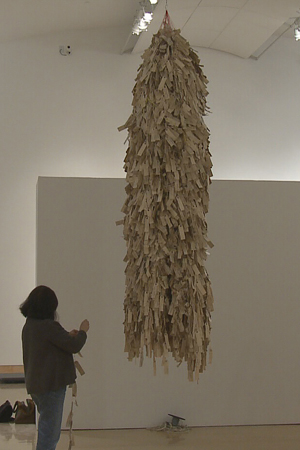Artist Explores Japanese Internment
SDSU professor Wendy Maruyama's

Local artist Wendy Maruyama’s exhibition "The Tag Project" opens on Feb. 6 at the University Art Gallery on the campus of San Diego State University.
Maruyama’s innovative work presents 120,000 recreated paper identification tags; each tag represents an individual of Japanese descent who was imprisoned in one of the 10 internments camps throughout the U.S. during World War II.
Monumental piece
The tags are grouped by camp, each grouping being approximately 11 feet tall and weighing more than 100 pounds. The installation, hung from the ceiling with a steel ring and cascading to the floor, is sculptural and asks visitors to contemplate the enormity and physicality of these communities.
“I was taken by the physical weight of the tags when completed and installed,” said Maruyama, a professor of furniture and woodworking in the SDSU School of Art, Design and Art History. “Despite appearing light and airy, the monumentality of tags is shocking upon first impression.”
Each tag includes the handwritten name of an individual along with an individual and unique identifying number. The tags were put through an aging process to replicate authenticity. Finally, tags were strung together by camp with red thread.
Wendy Maruyama's "Tag Project" is just one example of how the university engages the San Diego region, a key initiative of The Campaign for SDSU. Whether it’s supporting programs that contribute directly to San Diego's growth or building academic programs to prepare for the region’s future, SDSU is an important community partner. Learn more about SDSU’s community engagement and how you can contribute.
Inspired by origami
Maruyama was inspired by the thousands of paper folded origami cranes at the Hiroshima Peace Memorial Park and the photos of internees by Dorothea Lange. The latter highlighted the physical and emotional weight of the internment for Maruyama, and illustrated the effect of the internment on the Japanese-American community for years and generations to come.
“To this day, it shocks me to encounter a fellow American who has no clue that this is a part of U.S. history,” said Maruyama.
Interpreting the internment experience
Shown in conjunction with "The Tag Project," is "Executive Order 9066." This work is a personal interpretation of the internment experience by Maruyama, who collects World War II memorabilia and transforms them using her preferred medium of hardwoods. The juxtaposition of past and present is also further portrayed in this exhibition through the use of internee artifacts on loan from the archives of the Japanese American Historical Society of San Diego.
Both exhibitions are on view at the University Art Gallery at San Diego State from February 6 through May 3, 2012. Admission to the gallery is free.
"The Tag Project • Executive Order 9066" is organized by Tina Yapelli, director of the University Art Gallery at San Diego State University. The exhibition and special events are sponsored by the San Diego State University Art Council.
Additional support is provided by the School of Art, Design and Art History and the SDSU College of Professional Studies and Fine Arts. Further assistance for Mira Nakashima’s lecture is provided by Miyo and Mitch Reff and the Mingei International Museum. Funding for When Dreams Are Interrupted–San Diego is provided by the California Council for the Humanities California Stories Fund and the California Arts Council.
The Tag Project is funded in part by a grant from the California Civil Liberties Public Education Program, administered by the California State Library. Additional funding and project administration support is provided by the Japanese American Historical Society of San Diego. Additional funding also is provided by the San Diego Chapter of the Japanese American Citizens League and the San Diego State University Art Council.
Related Content
- Day of Infamy
Decades Ago at San Diego State: a look back at the start of World War II. - Present Righting of Past Wrong
SDSU confers honorary degrees upon Japanese-American students interned during WWII. - A Wonderful Gesture
A former Japanese-American student will receive an honorary degree as part of the CSU-wide Nisei College Diploma Project.



